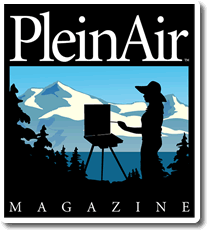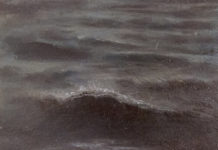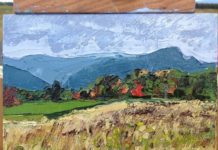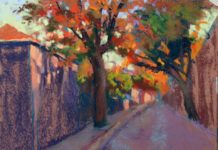
Virginia artist Eleanor Cox has years of experience as a plein air watercolor artist and teacher, and she has some advice to offer on techniques and procedures. Cox recently returned from teaching a workshop in Provence, France, and she shares photographs and recommendations from that trip.
“Landscape painting is my passion, and painting from life affords an opportunity to really see and experience the light, smells, and sounds associated with a landscape,” says Virginia artist Eleanor Cox. “I’m constantly challenged by the process of painting outside, responding to a scene, choosing a shady spot, organizing a painting from what is in view, and completing it in about two hours or less, before the light changes. I also do studio paintings from print photographs or a digital image on my iPad, and I find it better to teach in a controlled studio environment with the students using photo references. However, the ambience of being outside is undeniably my preferred way to paint.”
Cox goes on, “I almost always stand to paint so I have complete freedom of motion and can place the watercolor paper so it is nearly straight up and gives me an undistorted view of the evolving image. I do a thumbnail sketch of potential compositional arrangements in order to familiarize myself with the scene, then I draw light outlines of the most important shapes on the watercolor paper using a .09 mm mechanical pencil, and then I proceed with painting.
“I paint using a small, simple palette of warm and cool primaries, including permanent rose, cadmium scarlet, aureolin yellow, cadmium yellow pale, cadmium orange, cobalt blue, French ultramarine blue, manganese blue nova, Antwerp blue, viridian, quinacridone burnt orange, and also quinacridone gold and sienna.
“I like using fresh color on white paper, and mix the paint on the paper rather than on the palette because that helps me achieve a spontaneity and freshness when the watercolor is wet and the colors merge in the passage. Knowing which colors produce these effects comes from experience and time-honored painting. I frequently use Arches 140 lb. rough or cold-pressed paper for plein air work. I am also fond of Saunders 140 lb. rough and cold-pressed paper. I generally paint on quarter sheets, 11” x 14”, and support the paper by taping it to Gatorboard. I also have a small pad of assorted watercolor papers I assembled from sheets of 10” x 11” paper.”
Cox says, “My plein air supplies fit nicely into a backpack or carryall bag and include a Holbein folding metal palette, my favorite brushes — Cheap Joe’s Dragon’s Tongue Escoda rounds — a small Winsor & Newton field box, a watercolor sketch book, and the homemade watercolor pad. I also carry a Jullian half-box travel easel.
“I tend to start painting with a round brush from the bottom of the sheet and I gradually work my way up while painting overlapping or tangential shapes. If the painting is complete by the time I can get to the top of the paper, great. Otherwise, I do a bit of layering as necessary.
“I plan several plein air workshops a year, usually one abroad and one at Nags Head, North Carolina. I also teach closer to home at Nimrod Hall in Bath County, Virginia, and at Cape Charles on Virginia’s Eastern Shore. During a workshop, I choose painting sites that offer students the opportunity to paint both distant and close-up views. When the workshop is taking place abroad, I suggest the participants make sketchbook drawings and or small watercolors at a café table, while sitting on a bench, or perched on a low wall. Easel painting can be done in a busy setting, but is easier to manage in the field.” For more information, visit www.eleanorcox.com.
(Due to the age of this post, some images may be missing from this article)




